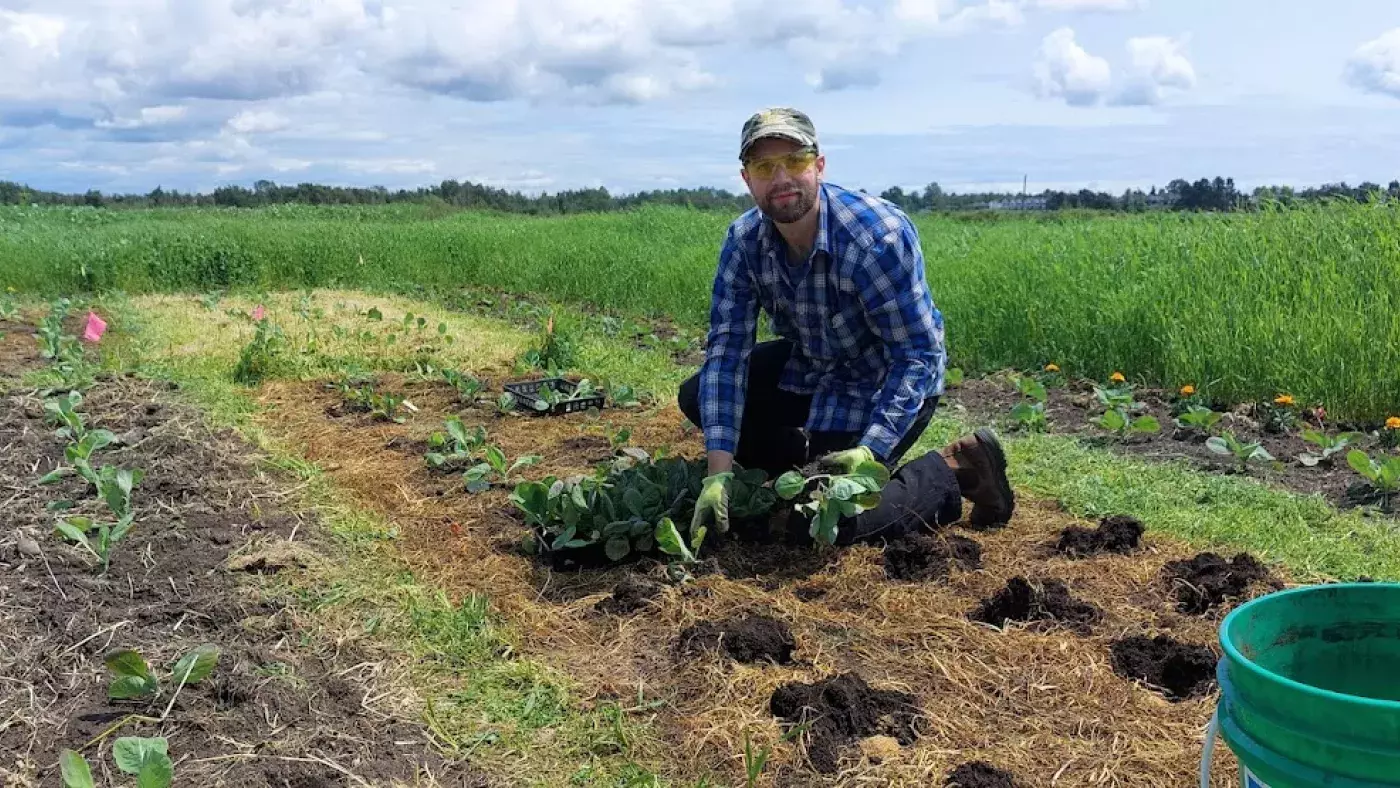

Sustainable Agriculture Student Research Project
Mow and Cover: Cover Crop Management Using No-till Practices in a Market GardenBenjamin Alles, Department of Sustainable Agriculture and Food Systems, 2022 |
Introduction
There are a vast number of benefits associated with the use of cover crops and no till management in crop production. Andrew Mefferd states that “No-till is as much about climate change as it is about soil health as it is about farm profitability.” and that “no-till growing practices are a way to improve all three” (2019). However the adoption of these methods and research surrounding them is usually in regards to large-scale field crop production. There is a need for research, and room for these methods to be adopted by small-scale organic growers as the benefits to soil health and weed suppression are present. Elliot Coleman highlights the room for research in this area saying that “while the general concept is workable, it's the specifics that need refining" and that “the idea is worth serious consideration. But it has to be done in a way that is more efficient rather than more complicated for the grower or it won't happen" (2018).
This research was conducted to evaluate cover crop termination, weed pressure, and labour use in organic cabbage grown with various combination of tillage and mulch.
- Hypothesis 1: No-till methods can be used to manage cover-crops and prepare fields for plantings vegetables as effectively as tillage management.
- Hypothesis 2: Mulching can be used to suppress weeds and reduce weed pressure and increase crop yield in vegetable crop production
- Hypothesis 3: The use of mulch is required to manage weed pressure and produce a yield comparable to conventional methods when using no-till methods to manage cover-crops.
Methods
- Location: Garden City Lands, Richmond B.C.
- Randomized complete block split-plot factorial design
- Oat/pea cover crop established before study
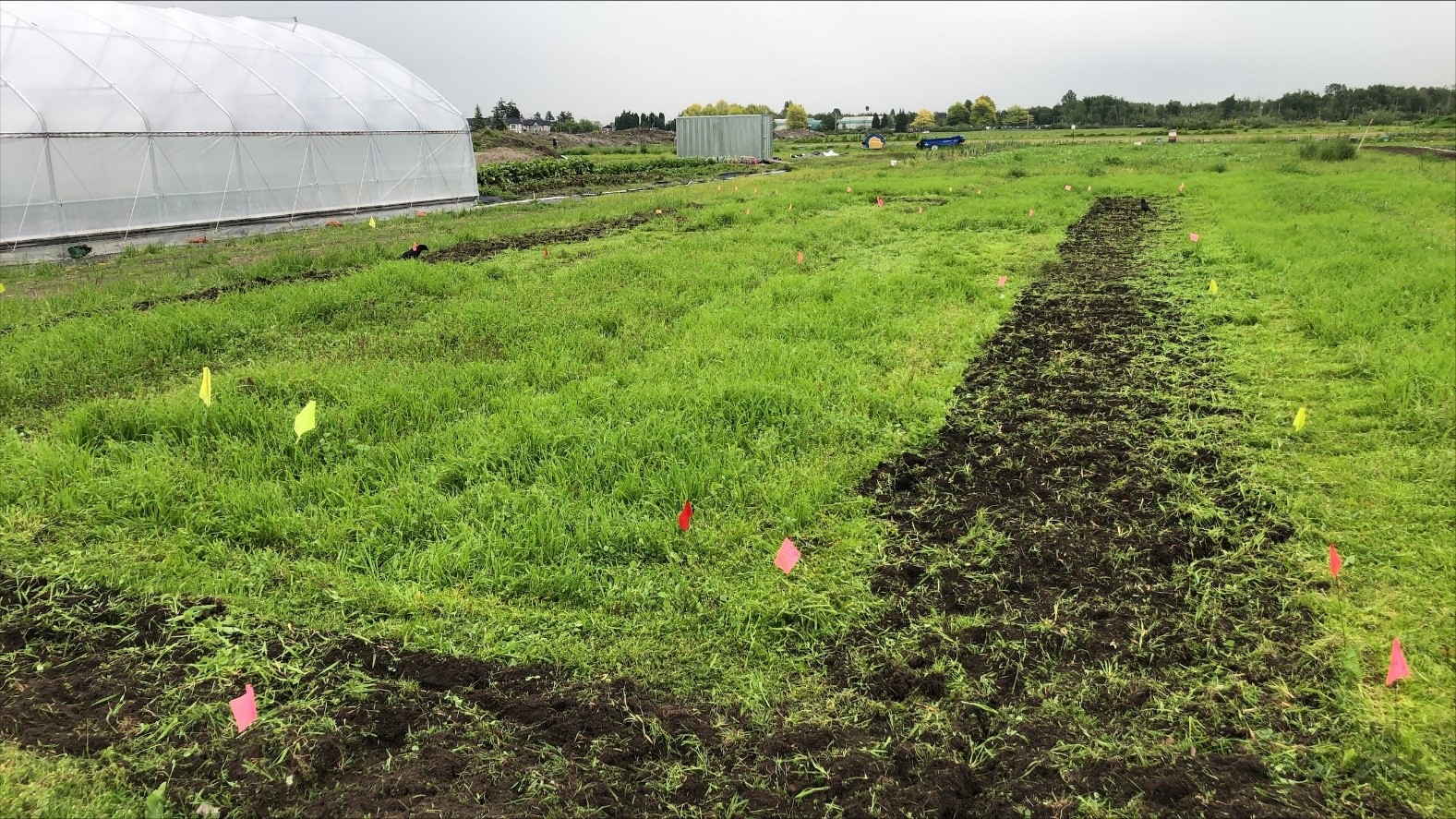
- Three cover crop termination treatments (main plots):
- Mow only ( 5 days before planting)
- Mow and cover with silage tarp (18 days before planting)
- Mow and till (5 days before planting)

- Three mulch treatments (subplots):
- No mulch
- Straw mulch
- Composted mushroom manure mulch (Compost)
- Nine four-week-old tiara cabbages were transplanted into each subplot
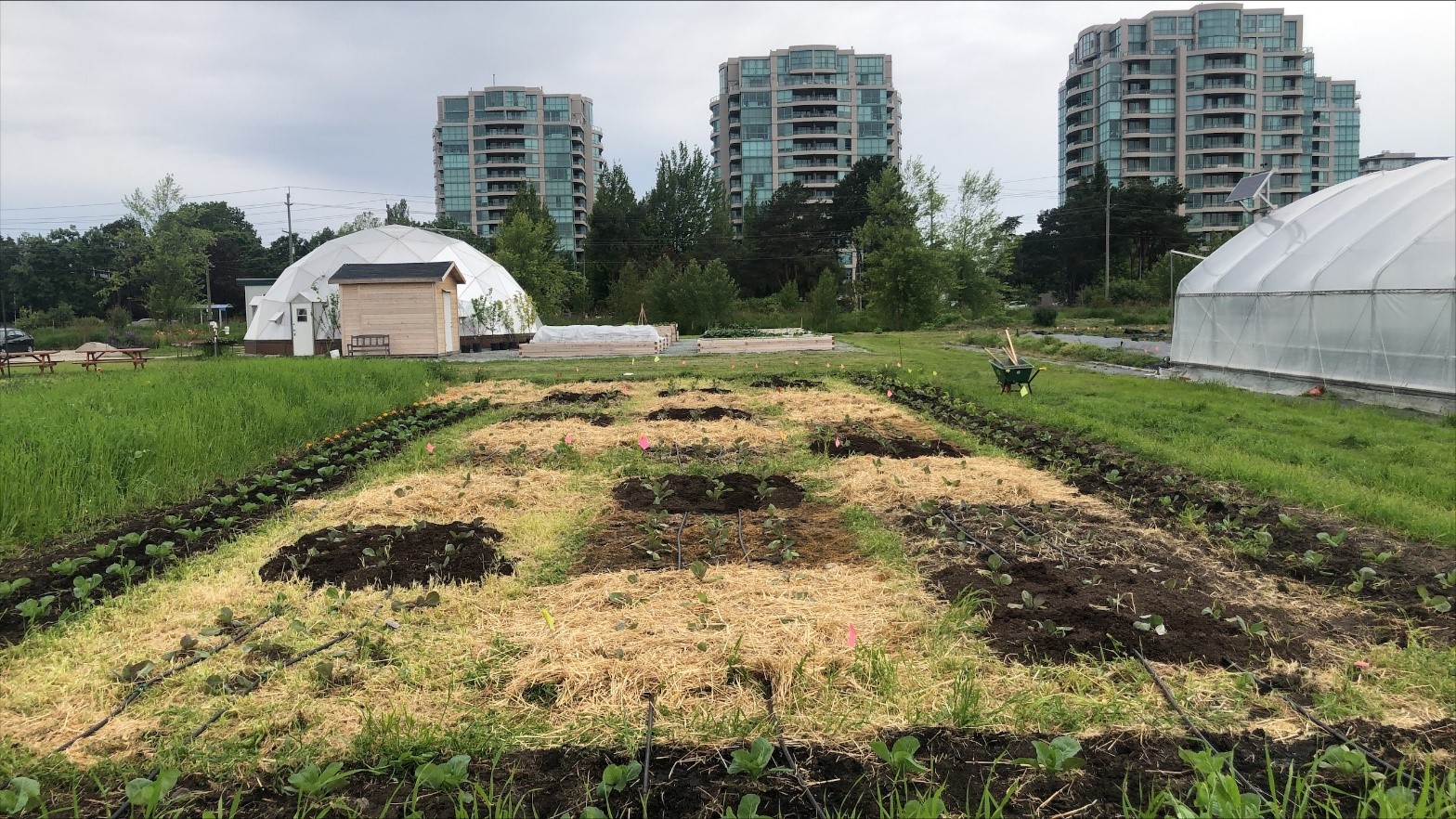

Data Collection
- Ease of planting was recorded on a 5-point scale, according to how much effort was required to dig a hole to plant a seedling:
- Very easy planting – with hands
- Easy – planting with hands but some difficulty
- Moderate difficulty – planting with shovel
- Difficult – planting with shovel, resistance
- Unplantable
- Management time
- Planting time was recorded for each subplot
- Mulching time was recorded for each subplot
- Weeding time was recorded for each subplot three times at one week intervals until cabbage canopy closure occurred
- Weed cover and biomass
- Weed cover was calculated using an app that determined % ground cover (Canopeo)
- A top-down picture was taken and processed through the app before and after weeding each sub-plot and the % ground cover removed was recorded
- Biomass of weeds was determined by harvesting weeds from the plots post-harvest
- Weed cover was calculated using an app that determined % ground cover (Canopeo)
- Cabbage yield
- Fresh cabbage weight was recorded for each subplot
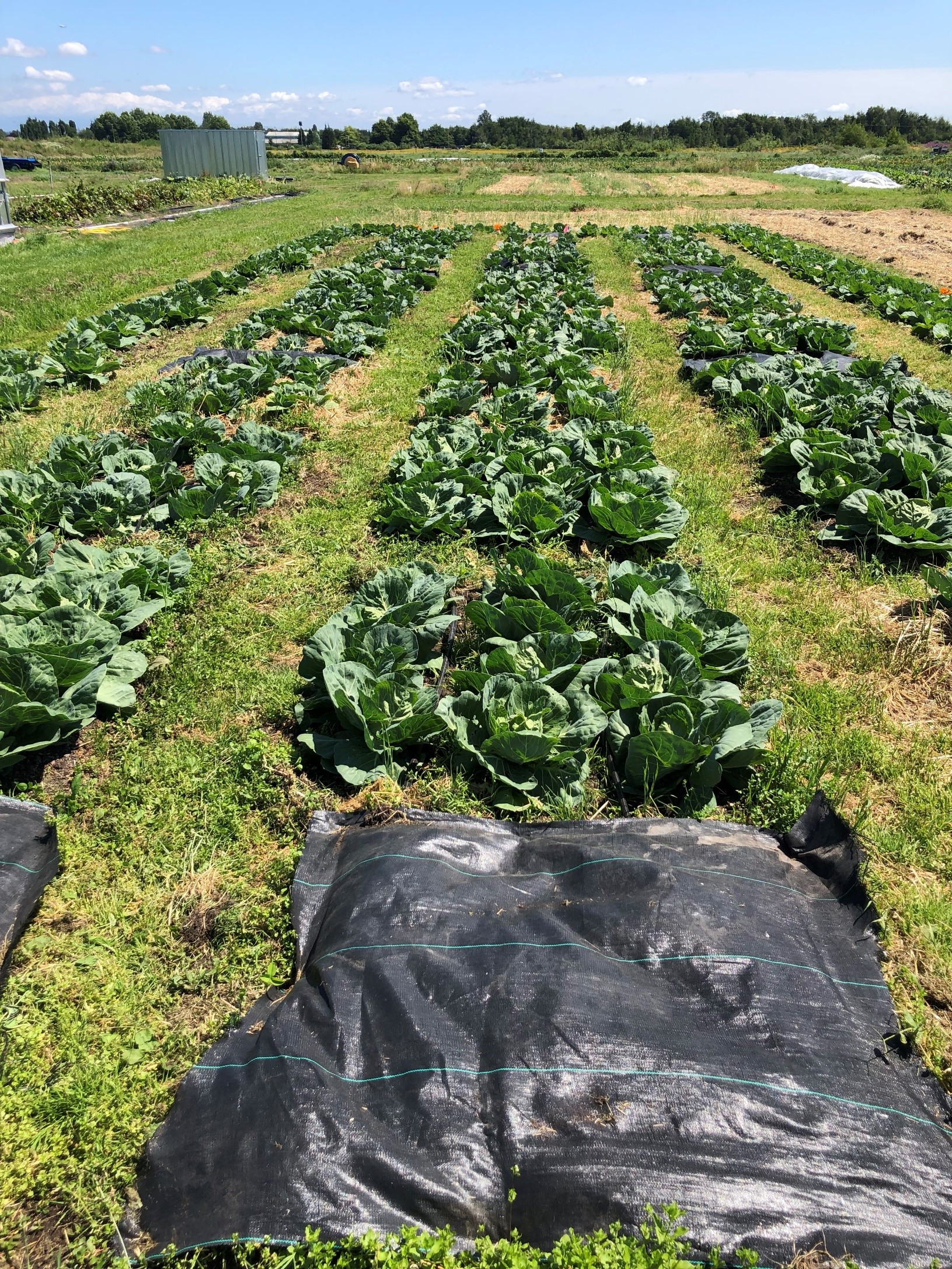
Statistical analysis
- Mixed-model analysis was conducted using the GAMLj module of the jamovi interface for R.
- Dependent variables were:
- Ease of planting
- Time spent planting
- Time spent mulching
- Time spent mulching and planting
- Time spent weeding (LN transformed to achieve normal distribution)
- Time spent planting, mulching, and weeding
- Ground cover removed (LN transformed to achieve normal distribution)
- Final weigh of weeds (LN +1.5 transformed to achieve normal distribution)
- Yield
- Fixed Factors
- Tillage treatment
- Mulch treatment
- Cluster Variables (Random effects)
- Plot
- Block
- Dependent variables were:
- Bonferroni post hoc means separation was conducted if significant differences (p0.05) were detected between tillage treatments, mulch treatments or the interaction between tillage and mulch treatments.
- Significant differences were noted if the Bonferroni p-value was less than 0.05
Results
Significant treatment effects were found for:
- Ease of planting (among tillage treatment)
- Time Spent mulching (only mulch treatment was considered)
- Time Spent Weeding (Among mulch treatment, tillage treatment and the interaction between the two)
- Time spent overall: planting, mulching and weeding (among tillage treatments)
- Total ground cover removed (among mulch treatments and tillage treatments)
- Final weight of Weeds (among mulch treatments)
No significant treatment effects were found for:
- Time spent planting
- Yield
Ease of planting
The plots that were tilled were significantly easier to plant (p0.05) than either no-till treatment. The mow and cover plots were easier to plant than the plots that were mowed but not covered.
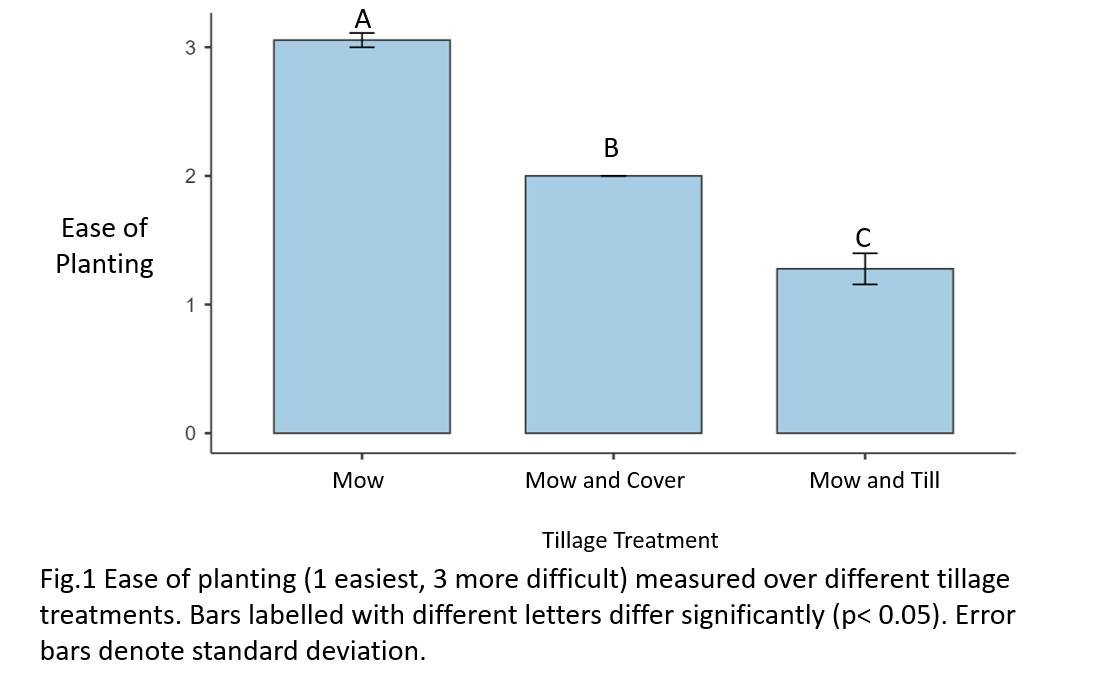
Time spent mulching
The composted mushroom manure took significantly longer to spread than the straw mulch (Fig. 2).
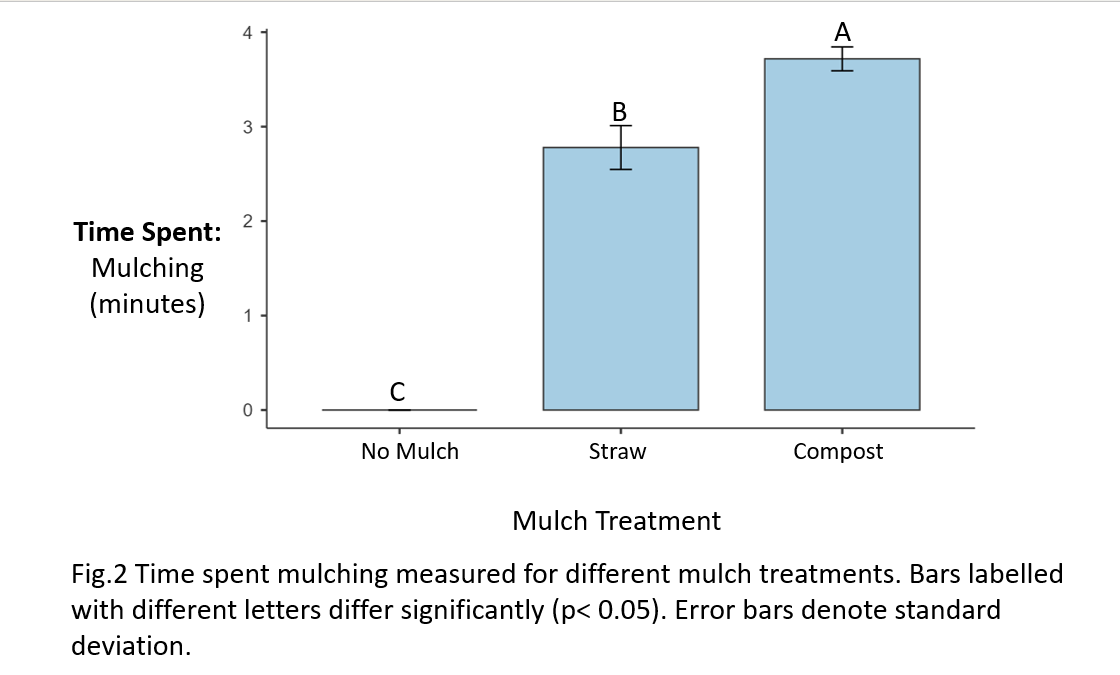
Time spent weeding
There was significantly (P0.05) less time spent on the mow and cover plots compared to both other treatments, and less time spent on the tilled plots compared to the mowed plots. Additionally, there was significantly (P0.05) less time weeding on the sub-plots that were mulched with either compost or straw as compared to the plots that weren’t mulched. There were also many significant interactions between mulch and tillage treatments. All mowed treatments no matter their mulch took the longest to weed. Mowed and covered treatments mulched with compost or straw took the least amount of time to weed, and tilled treatments mulched with straw took longer than mowed and covered crop with mulch, but not significantly longer amount of time to weed (Fig. 3).
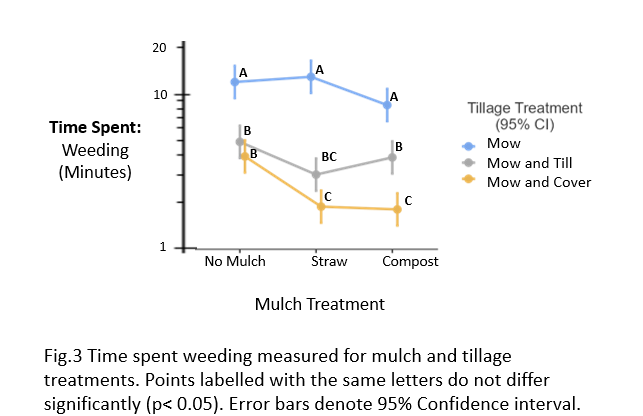
Time spent planting, mulching, and weeding
There was significantly (P0.05) more time spent overall in the plots where the cover crop was only mowed as compared to the plots where the cover crop was mowed and covered or tilled into the soil (Fig. 4).
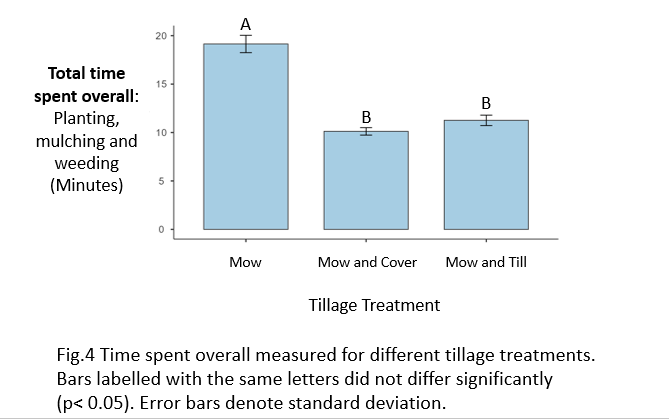
Ground cover removed
There were significant treatment effects observed both among mulch treatments and tillage treatments for ground cover removed. Sub-plots without mulch had significantly more ground cover removed during the growing season and the mow only plots had significantly more ground cover removed than the other two tillage methods. Although both treatment effects were significant, no significant interaction was observed.

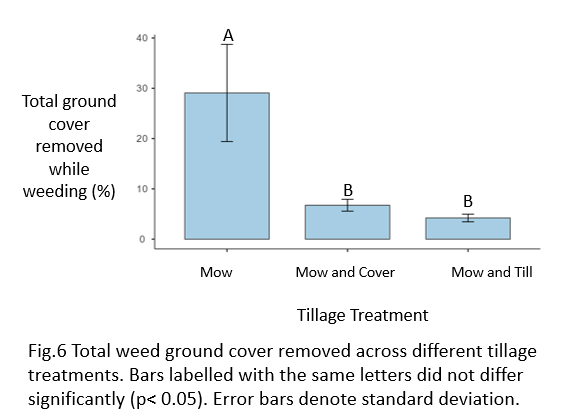
Final weight of weeds
There were significantly more weeds present in the plots without mulch at the end of the season as compared to plots with either straw mulch or compost mulch.
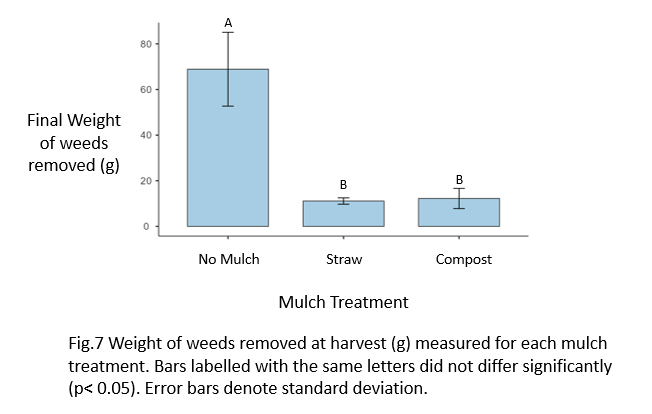
Discussion
Ease of planting
Although the tilled plots are easiest to plant into the mowed and covered plots didn’t make planting that much more difficult if a shovel was used. The remnant of the cover crop roots in the mowed plots that didn’t get covered made planting most difficult but planting was still very manageable. Overall there was no significant difference in time spent planting between the tillage methods.
Management time
The mulches were spread after planting and the spreading may have gone quicker if it was done before planting.
Mowed plots took the longest to weed because there was a lot of regrowth of cover-crops that had not been terminated by mowing.
The mowed plots overall had the longest management time mostly due to the time spent weeding. This shows that covering after mowing a cover crop is a crucial step to help with weed suppression. Not only is the cover crop properly terminated but it’s likely that weeds seeds in the top layer of soil are allowed to germinate under the silage tarp and then are terminated due to lack of sun, therefore creating a stale seed bed.
Weeds
Mulch was seen to provide significant weed suppression. Mowing and covering as well as mowing and tilling were able to prevent weed pressure when compared to mowing only.
Tarping was an important step in cover-crop termination for the no-till methods. Plots that were not tarped after mowing were the hardest to plant because of the presence of non-terminated cover-crop, had significantly more weed pressure due to regrowth of cover crop and sprouting weeds from a lack of creating a stale seed bed. Mulch was also important for weed suppression. The plots with no mulch had a greater coverage of weeds removed both during the growing season as well as after harvest. In the mow and cover plots there was also significantly more time spent weeding on the sub-plots without mulch. Regarding management time and weed suppression, there was no significant difference between straw and compost. Many cabbage seedlings had to be replaced in the first few weeks after transplanting because of a deterioration of the roots, potentially due to over-fertilization. Yield data had no significant results but may have been affected by this, regardless.
The benefits and effects of no-till management change and develop the longer the system is subjected to no-till management. For instance the tilth of the soil will likely develop to be easier to plant and the weed population will change the longer a system is subject no-till management. This experiment was intended to look at either the transition to no-till management or simply reducing the amount of tillage by implementing a period of no-till management into a system.
- Hypothesis 1: No-till methods can be used to manage cover-crops and prepare fields to plant vegetable crops without an increase of labor input. This hypothesis is partially accepted and partially rejected. Planting time was not significantly different for no-till treatments as compared to the tilled treatment, but the soil was easier to plant into for tilled treatments.
- Hypothesis 2: Mulching can be used to suppress weeds and reduce weed pressure and increase crop yield in vegetable crop production. This hypothesis is partially accepted, mulching was shown to help suppress weeds and reduce weed pressure however had no significant impact on crop yield.
- Hypothesis 3: The use of mulch is required to manage weed pressure when using no-till methods to manage cover-crops. This hypothesis was accepted. The mow and cover no-till treatment had significantly less time spent weeding and the no-till treatment without mulch had the same amount of time spent as the tilled treatment. Generally the treatments without mulch had greater weed pressure.
Conclusion
Mow and cover as a no-till method for managing cover crops is an effective way to reduce tillage. When this method of no-till management is paired with mulch it is able to reduce weed pressure and reduce overall time spent weeding without increasing labour or decreasing crop yield.
Acknowledgments
Composted mushroom manure was donated by Highline Mushrooms.
